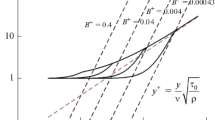Abstract
We are all familiar with the fact that a linear flow of water in a tube can be obtained only for velocities below a certain critical limit and that, when the velocity exceeds this limit, laminar flow ceases and a complex, irregular, and fluctuating motion sets in. More generally than in this context of flow through a tube, it is known that motions governed by the equations of Stokes and Navier change into turbulent motion when a certain nondimensional constant called the Reynolds number exceeds a certain value of the order of 1000 (P. Bradshaw, 1978). This Reynolds number depends upon the linear dimension, L, of the system, the coefficient of viscosity μ, the density ρ, and the velocity v in the following manner \(R = \frac{\rho vL}{\mu}\). Following (S. Chandrasekhar (1949), ApJ 110, 329) we can make us the question: What is the reason that a phenomenon like turbulence can occur at all?. We describe the turbulence in fluids as a consequence of the inherent discontinuity of matter. We start with the description of matter density as a discontinuous Dirichlet integral function, and through the Euler equation for matter conservation, we obtain a differential equation which implies a transference of velocity (and then energy) from one eddys to others, i.e. from one scale to another, which is one of the main observational features of turbulence.
Similar content being viewed by others
References
Bradshaw, P. (1978). In P. Bradshaw (Ed.), Topics in Applied Physics: Turbulence, Vol. 12, Springer-Verlag, Berlin.
Chandrasekhar, S. (1949). Turbulence a physical theory of astrophysical interest. Astrophysical Journal 110, 329.
Heisenberg, W. (1948a). Scale resolved intermittency in turbulence. Zeitschrift fur Physik 124, 628.
Heisenberg, W. (1948b). On the theory of statistical and isotropic turbulence. Proceedings of the Royal Society A 195, 402.
Taylor, G. I. (1935). Statistical theory of turbulence. Proceedings of the Royal Society A 151, 421.
Taylor, G. I. (1938). Production and dissipation of vorticity in a turbulent fluid. Proceedings of the Royal Society A 164, 15.
Chandrasekhar, S. (1955). A theory of turbulence. Proceedings of the Royal Society A 229, 1.
Saveliev, V. L. and Gorokhovski, M. A. (2005). Group-theoretical model of developed turbulence and renormalization of the Navier-Stokes equation. Physical Review E 72, 016302.
Author information
Authors and Affiliations
Corresponding author
Additional information
PACS: 47.27.E- Turbulence simulation and modeling.
Rights and permissions
About this article
Cite this article
Casuso, E. On the Origin of Turbulence. Int J Theor Phys 46, 1809–1814 (2007). https://doi.org/10.1007/s10773-006-9313-y
Received:
Accepted:
Published:
Issue Date:
DOI: https://doi.org/10.1007/s10773-006-9313-y




